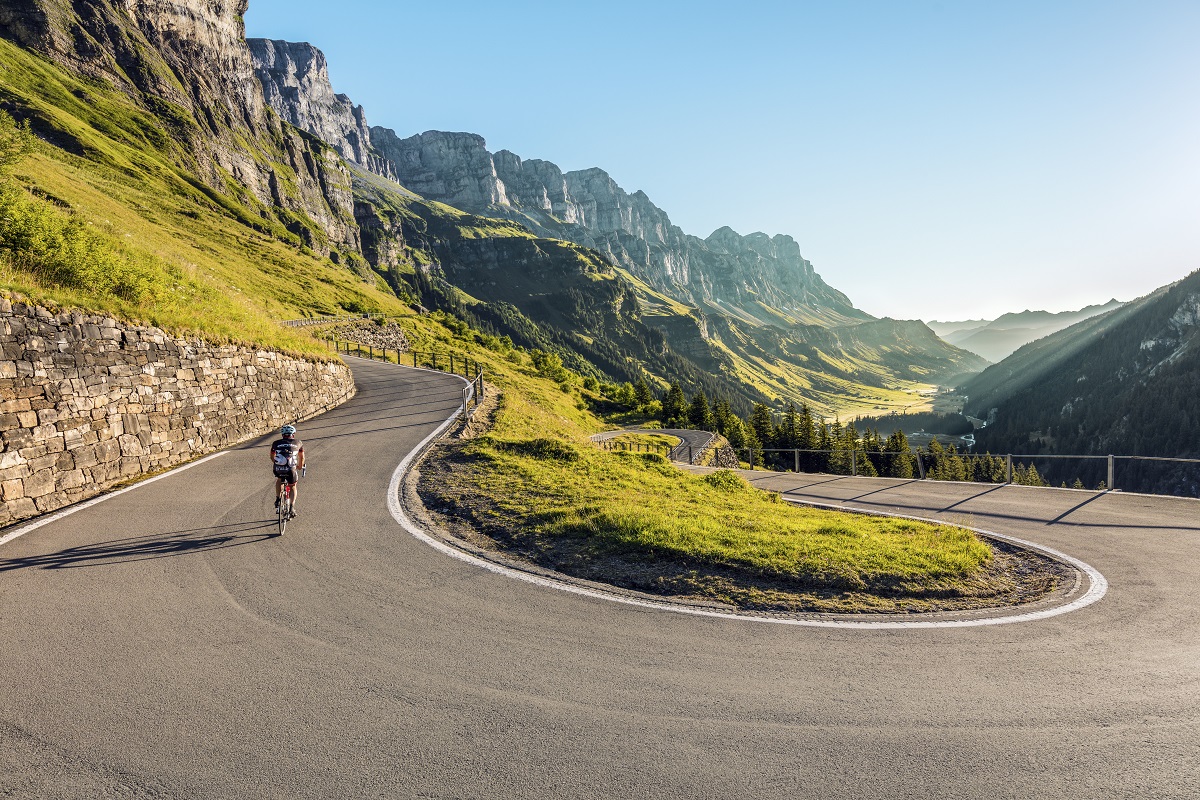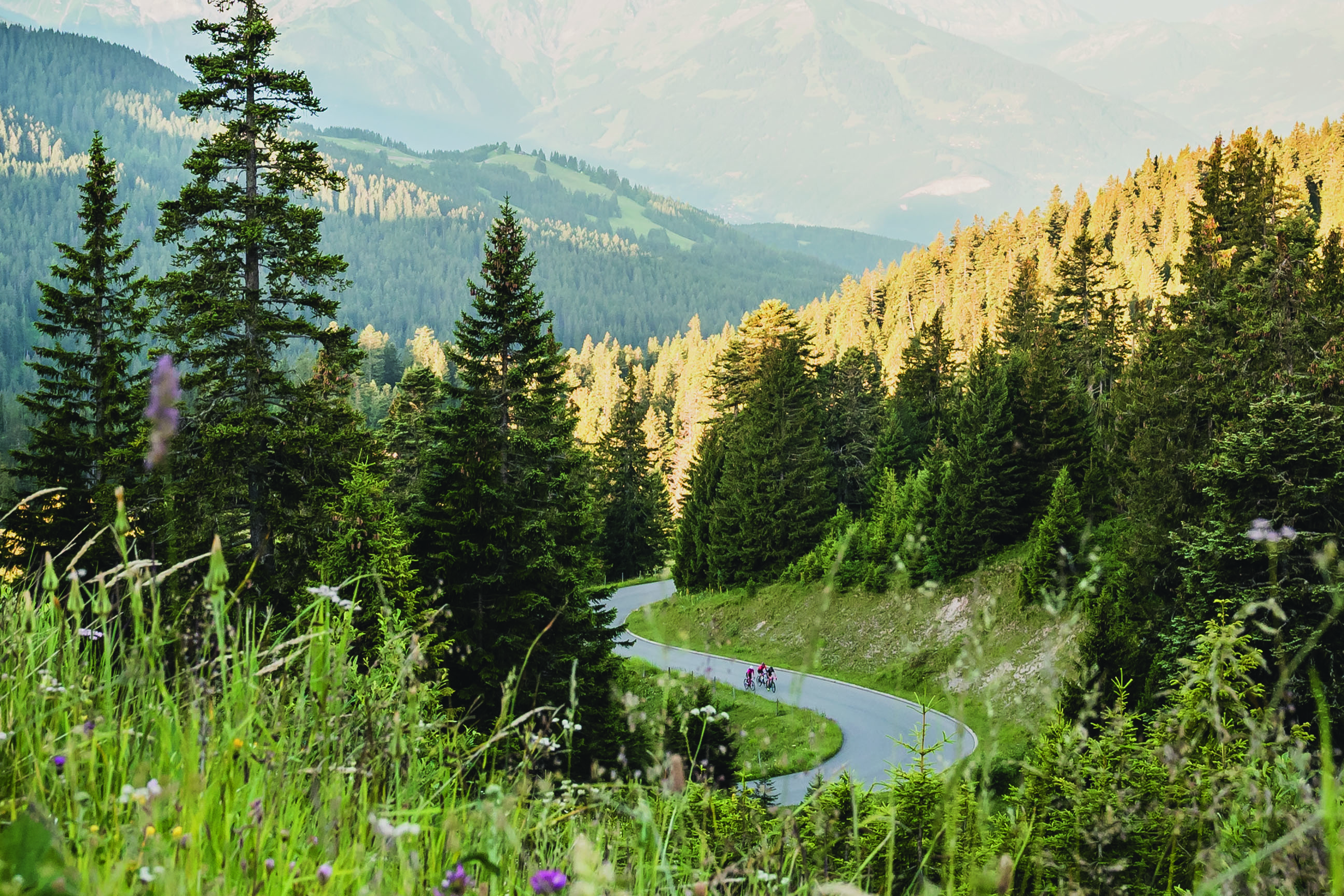Ride the Alps
The only thing better than cycling Switzerland’s stunning, switchbacking mountain roads is riding them when they’re closed to cars.
On select dates between May and September, car travel is restricted on select mountain passes and the roads leading to them. Many Ride the Alps-specific stages are free, although on charity fundraiser stages, a donation is expected. Some stages are shared events with registration fees. Do one or do them all—whatever your legs can handle.
Before the construction of Gotthard Tunnel, Lukmanier Pass was the only north-south connection between wild, rugged, mountainous Graubünden in the north and the sunny, flowering slopes of the Blenio Valley and southern Ticino. The ride is called the Kaiser Route as a nod to its dark history—the pass was periodically plundered by German emperors passing through Disentis en route to Rome to receive a Papal blessing.
Susten Pass connects the Reuss Valley, at the foot of the Gotthard, with the Hasli Valley in the Bernese Oberland and the village of Wassen, in Uri, with Innertkirchen in Bern. This mountain-pass road opened in 1945 and was the first Alps pass designed specifically for car traffic. On the Gotthard side, the road crisscrosses the Meienreuss River Gorge via several tunnels and summits. On the Bernese side, riders are treated to stunning panoramas of the Gadmen Valley, Steinen Glacier and Lake Engstligenalp. The tour starts and ends in Meiringen, famous for nearby Reichenbach Falls, site of the final showdown between Sherlock Holmes and his nemesis Professor Moriarty. And, the village claims to have created the first meringue.

The neighboring resorts of Crans and Montana sit on a sunny plateau high above the Rhone Valley. They’re one of the biggest holiday destinations in Valais. This ride has two loops that include mellow riding along the Rhone, climbing through riverside vineyards, traditional Swiss villages and an unrelenting uphill to the welcoming summit and views of the Weisshorn.
Fron Chur to Arosa, the road has 360 bends, many of which are switchbacks. The winding Schanfiggerstrasse is flanked by idyllic mountain villages on both sides. The road was used as a bobsled and toboggan run from 1897 to the 1930s. Now, it’s extremely popular with auto and moto clubs, and it’s been featured 11 times in the Tour de Suisse.
Oberalp Pass links Disentis/Muster in Graubünden with Andermatt in Uri. The 6,700-foot pass is the highest point on the Glacier Express, with views of Oberalp Lake right before the summit. Disentis/Muster is the site of one of the oldest Benedictine monasteries in Switzerland. Andermatt lies at the heart of the Urseren valley at the crossroads of eight mountain passes and the source of four powerful Swiss rivers.
Col de la Croix connects Les Diablerets with the Rhone Valley. Together with Col de Mosses and Col du Pillon, this ride is a cycling rite of passage. The ride ends in the village of Villars, which overlooks the Rhone Valley with Mont Blanc views from every street corner. Aigle is best known for its Chablais-producing vineyards. Villars-sur-Ollon, located in the heart of the Lake Geneva Region, gives already breathless riders views of the Dents-du-Midi and the Mont Blanc massif all the way to Lake Geneva.
Gotthard is considered a historic monument. It’s been protected since 1951 when it was fully reconstructed. At that time, the cobblestones were restored, as were the stone kilometer markers.

The Tour de France and Tour de Suisse, made the Col de la Croix de Coeur famous after both of the races passed over it in 2009. The road has a dozen switchbacks and ends with an unpaved section to the top.
The Tour de France and Tour de Suisse, made the Col de la Croix de Coeur famous after both of the races passed over it in 2009. The road has a dozen switchbacks and ends with an unpaved section to the top.
Crossing Susten, Grimsel and Furka passes is a challenging route through the heart of the Swiss Alps. It has more waterfalls, glaciers, hairpin turns and tunnels than most riders will ever see in a day. It also has 12,000 feet of climbing. Glimpses of the Rhone Glacier will distract you from the pain in your legs. And if you’re a James Bond fan, so will Furka Pass, which was featured in Goldfinger.
Glorious views are guaranteed on the ride through the weathered Albula Gorge en route to Bergun. Steep rock walls prevented traders from plying their wares here until 1696 when a passage was blasted through the rock. It was the first time gunpowder was used for road construction in this region. The route is narrow and more popular with cyclists than drivers.
Flüela Pass is the northernmost point in the Swiss Alps and connects the highest town in Europe – Davos, located in the Landwasser Valley, with Susch—found in the Lower Engadine. Flüela Pass travels through exceptionally pristine mountain scenery, which earned it a fourth place ranking from Avis in 2015 as one of the world’s best roads.
The 6.5-mile climb to Emosson Dam averages 8.4%, but ti tops out at a brutal 12.3%. The ride finishes next to the impressive Lac d’Emosson Dam, just feet from the French border. At the top, majestic Mont Blanc looks so close you could touch it. The route was part of the 2017 Tour de France Stage 17.
Linthal, the southernmost municipality of the Glarus Region, is not only the source of the Linth River, but the departure point for hikes and mountain tours and the famous Klausen motor races. The road climbs Klausen Pass through the enchanting Schächental Valley, the historic home of William Tell, with cool views of Stäubifall waterfall. While Pragel Pass is not as high, in some sections the grade is 14 percent.
 The Magazine of The Sierra Club
The Magazine of The Sierra Club